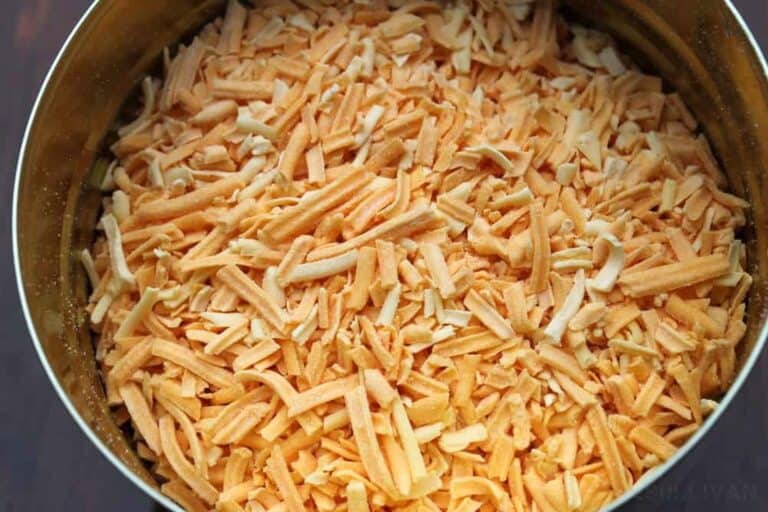One of the best ways to preserve food for long-term storage is to freeze-dry it. Also known as Lyophilization, freeze-drying is a process that completely hinders bacterial growth and reduces the weight to a fraction of what it was.

It’s no surprise that this kind of food has dominated the camping section of stores.
The military also takes advantage of the lightweight benefits that freeze-drying provides for their rations.
With a reputation as good as it has, just how long is the shelf life of freeze-dried food?
Freeze-dried food will last you anywhere between 7 and 25 years unopened depending on storage conditions. An open package should be eaten within a few days.
While the process isn’t complicated there is a lot going on when you freeze-dry something. It can be rather expensive as well, which is why a lot of it costs so much money.
If you’re new to the concept then keep reading to learn more about this incredible preservation technique.
The Freeze Drying Process
Freeze-drying your food is generally done in three steps. First, you must freeze your food.
Second, you need to add pressure and heat to cause sublimation. Afterward, there is another drying phase to get rid of any remaining moisture.
Generally, you want to have the moisture sitting between 1-5% for optimal storage.
Step 1: Freezing
Cooling your food using a freezer or an actual freeze dryer below the triple point will ensure that it will not melt, retaining its shape and texture.
The key to this process is you want to freeze it quickly so the cell walls don’t break down.
Step 2: First Drying
Adding pressure and heat to the product will force sublimation. Sublimation is where solid matter turns into a gas without first turning into liquid.
This is the largest drying step and over 90% of the water will be removed during this process.
Step 3: Second Drying
The last step is adsorption (no that wasn’t a typo) and it gets rid of the remaining water and is responsible for leaving that porous interior that is common in freeze-dried foods.
As you raise the temperature higher than the first drying phase the water molecules will separate from the physical matter.
That’s all there is to it, simple right? It can be complicated to wrap your head around but thankfully we have the technology to help us out in the process.
Why Freeze-Dried Foods Have a Long Shelf Life
As food ages, it breaks down and bacteria starts to eat away at it.
As the bacteria digests the food they will leave behind refuse that are toxic. This is what gives rotting food its look and smell.
Well, the driving force behind this is moisture and it is the enemy of food preservation.
Since you move up to 99% of the moisture with freeze drying it effectively becomes a hostile environment where bacteria and mold cannot grow.
The complete absence of moisture will keep the food in a sort of stasis until it gets reintroduced to water.
What Affects The Shelf Life of Dried Foods?
There are a few factors that impact the shelf life of any dried food. Freeze-dried food is more susceptible to moisture penetration since it acts like a sponge.
Storing, opening, and consuming freeze-dried foods have their own factors affecting the quality and edibility of the food.
| Freeze Dried Food | Shelf Life | Factors |
|---|---|---|
| Sealed | 20+ years | Consistent temperatures are needed. Keep out of a damp environment. |
| Opened, not rehydrated | 7-10 days | Direct sunlight and condensation will cause the food to spoil. |
| Opened, hydrated | 1-2 days (depending) | Keep it in the fridge or someplace cold. |
How Long Does It Last Once Used?
I love freeze-dried food because it maintains the original texture and flavor of whatever meal you’re rehydrating.
Once you’ve opened the meal and rehydrated it then you should treat it much like a fresh meal and consume it within a couple of days.
If you’ve opened the package and left the contents as they are you have a little more time to eat it.
Keeping it out of direct sunlight and away from any form of moisture (rain, condensation, sweat) then you’ll have up to a week to eat it.
How To Tell If Freeze-Dried Foods Have Spoiled
Moisture, oxygen, and light are all bad characteristics in the world of freeze-dried foods. Any combination of these three will guarantee bacteria growth in your food.
Here are the common ways to tell if your freeze-dried food has gone past its shelf life:
- The texture should be crunchy and porous – If you put a piece in your mouth it should melt in your mouth. If it has a wet and slimy texture, don’t eat it.
- It should smell like the original food – This process preserves the smell of the item. This means that the fruit should smell like the fruit and nothing else. If you get an ammonia or rotting smell it should be thrown out.
- The food should have the original color – Freeze-dried food has the same color as it did before. Sometimes the color is even more vibrant as the moisture was leached out. If your freeze-dried food is faded there is a chance it has expired.
- It should be free of discoloration – There are instances of mold setting in if there is too much oxygen in the packaging. Any kind of imperfections that weren’t already present should prompt you to discard the food.
What Are The Best Foods To Freeze Dry?
Just because you can freeze dry any food doesn’t mean you should freeze dry everything.
Luckily, the process is much less altering than dehydrating and there are a large number of items that benefit from the process. Let’s take a look at some of the more popular choices for freeze-drying.
Freeze Dried Fruits
One of the best ways of preserving fruit is hands-down freeze-drying. The natural sugar content of the fruit is enhanced in the absence of moisture.
The shelf life under ideal circumstances can be upwards of 30 years.
It is an economical way to have fruit all year round. Lightweight and nutritious, it’s perfect to beef up your prepper stockpile or camping kits.
Most preppers will agree that freeze-drying your berries is a better solution than simply dehydrating them as more moisture is expelled.
Freeze Dried Veggies
Much like the fruit, freeze-dried veggies retain the flavor and texture profiles of the originals. A sealed mylar package of freeze-dried veggies will stay shelf stable for up to 30 years.
Common amongst backpackers, freeze-dried veggies are a great way to add nutrition and calories to any meal on a hike. Be sure to keep it away from sunlight and moisture.
Freeze Dried Eggs
Not to be confused with dehydrated eggs, freeze drying is the superior method to preserving your farm-fresh eggs. Properly stored, this versatile food will last up to 20+ years.
The nice thing about reconstituting freeze-dried eggs is that the final product isn’t rubbery or congealed but rather similar to the original texture.
Additionally, the size of the final product is remarkable as you can fit over 40 eggs into 2 1 quart mason jars.
Freeze Dried Meat
Imagine being able to keep your meat shelf stable for 25+ years. Surprisingly, meat is one of the best contenders for this process.
Meat is an excellent source of protein and B12 which might be difficult to come by in a survival situation.
When rehydrating the meat will only take as much water as it needs and should be of a similar size to the original.
The texture might be slightly altered but should rarely be noticeable. Ensure you eat opened products within a week.
Freeze Dried Food vs Dehydrated Food
Some people use freeze-dried and dehydrated synonymously, however, they are very different processes with different results.
Dehydrated food will have more moisture than its counterpart so a lot of the final products will be squishy.
Since freeze drying eliminates up to 99% of moisture, everything is generally hard and crumbly.
Freeze-drying your food also preserves a lot of the nutrition that is lost during the dehydrating process.
For more information on this topic check out our article regarding freeze-dried and dehydrated food differences!
Final Thoughts
Many preppers consider this the best way to preserve any kind of food that needs an extended shelf life.
It is an innovative process that drastically reduces the moisture content of any food without sacrificing nutrition or texture.
The convenience of it can be found in its lightweight characteristics and the fact that you really only need hot water to turn it back into a meal.

Perrin is an adventure guide and naturalist currently living a nomadic life in the Canadian wilderness. His education and expertise is in wilderness survival and wildlife tracking. He enjoys teaching people about the outdoors and has managed large groups on expeditions.
With several accredited certifications, including being a wilderness first responder and a leave no trace expert, Perrin believes it is important for all of us to reconnect with the natural world.
